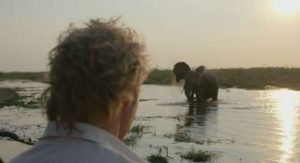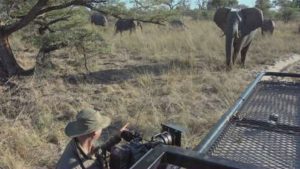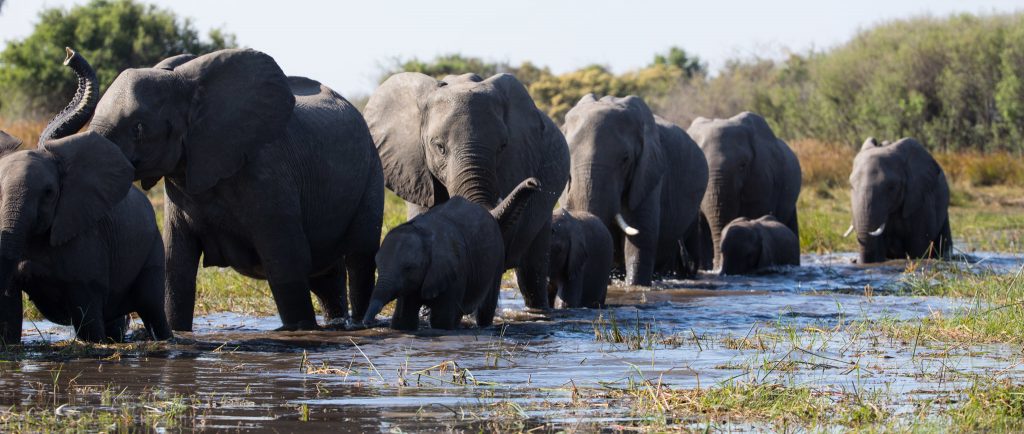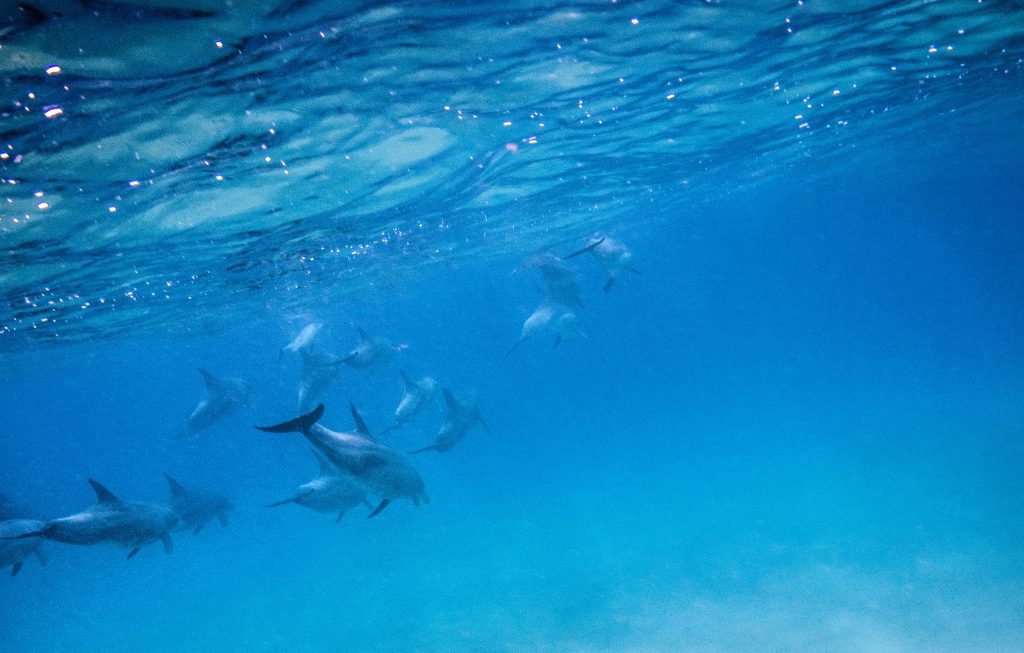April 3, 2020
by Carla Hay

“In the Footsteps of Elephant” (2020)
Directed by Vanessa Berlowitz and Tom Stephens
Culture Representation: This documentary takes a behind-the-scenes look at the making of the Disneynature documentary “Elephant,” which has a predominantly white film crew (with some black members) chronicling the journey of a herd of elephants in southern Africa, as they travel across the Kalahari Desert, from the Okavango Delta to the Zambezi River.
Culture Clash: The film crew often has to deal with bad weather, technical limitations and the possibility of being attacked by some of the wild animals they encounter.
Culture Audience: “In the Footsteps of Elephant” will primarily to people who have an interest in how nature documentaries are made.

Before seeing this movie, it’s essential to first watch the Disneynature documentary “Elephant.” That’s because “In the Footsteps of Elephant,” a feature-length documentary about the making of “Elephant,” has a lot of spoiler information that will reveals the outcome of the suspenseful moments in “Elephant.” Narrated by actor Jeremy Sisto (who was not part of the on-location film crew), “In the Footsteps of Elephant” is a worthy companion piece to “Elephant.” If “Elephant” had been released on home video, instead of being exclusive to the Disney+ streaming service, “In the Footsteps of Elephant” would be the equivalent of the “behind-the-scenes” extras part of a home-video release.
“Elephant” documents the journey of a herd of elephants in southern Africa, as they travel across the Kalahari Desert, from the Okavango Delta to the Zambezi River and back again. It’s a 1,000-mile round-trip journey that can take up to eight months. So it comes as no surprise that filming of all it was a very difficult challenge. In addition to dealing with bad weather, which sometimes delayed production and caused vehicles to be stuck in the mud, the film crew often had to figure out several logistical problems, in terms of how and where to position the cameras.
Ultimately, the crew used three different ways to film “Elephant”—by vehicle, by drone and by helicopter. The filmmakers had custom-built transportation called “swamp trucks” for the shoot. And sometimes, such as when the drones had to film over the massive and powerful Victoria Falls, they were in danger of damaging their equipment.
Although “Elephant” was directed by Mark Linfield, this documentary shows that he wasn’t the biggest, extroverted personality in the crew. That title goes cinematographer Mark Holding, who has more than 20 years of experiencing filming in the Okavango Delta. He did much of the main prepping in pre-production with Linfield, so the director would know what to expect.
Holding might remind some people a little bit of the late “Crocodile Hunter” Steve Irwin because of their physical similarities, although Holding isn’t quite as over-the-top with his enthusiasm as Irwin was known to be. Holding says half-jokingly that he prefers being around wild animals than most people. In the documentary, Holding comments that flying over the Okavango Delta is “absolutely the way to see it. It’s absolutely spectacular to see.”
As a director, Linfield seems to have maintained a calm and measured presence on the set. In interviews, he appears slightly annoyed but not rattled when unexpected delays happen because of the stormy or other bad weather. That’s because Linfield is an expert in filming wildlife and nature documentaries—all of his directorial credits have been so far have been filming Disneynature documentaries, starting with 2009’s “Earth.” Linfield is also married to Vanessa Berlowitz, who co-directed “In the Footsteps of Elephant” with Tom Stephens.
Another key member of the crew was biologist Mike Chase, who is described in the documentary as someone who’s been tracking elephants for more than 10 years. Chase is also the founder/director of an organization called Elephants Without Borders, which is a sanctuary for abandoned or abused elephants, and advocates against elephant poaching. (At the end of the documentary, there’s some adorable footage of Chase and other members of the Elephants Without Borders team feeding some orphaned elephants.)
Chase, who says his family has lived in Botswana for five generations, comments on elephants and his passion for rescuing and protecting them: “I’ve always been mesmerized by them … I think people around the world all too often think there are a lot of people saving the elephants—and there aren’t, really. So, to be part of a privileged few committed to safeguarding the future of elephants, I derive a great amount of enjoyment from that.” Later in the movie, he tears up and gets emotional when he says that elephants will probably become extinct at the rate that they are being killed.
Clinton Edwards, a field guide, provides a lot of the documentary’s humor. He’s easily the “class clown” of the group, by cracking jokes and making light of tough situations. There’s also a funny scene where he falls asleep when he’s supposed to be keeping a lookout for lions. His snoring alarms a fellow crew member at first because it sounds like a lion’s snore.
Camping and filming in the middle of the territory of wild animals obviously put the crew at risk. The documentary includes two of the scary moments caught on camera. In one scene, dive assistant Mathieu Van Goethem had a close encounter with a crocodile while diving underwater. The crocodile was hidden and almost blindsided Goethem, who quickly got out of the water before the crocodile could attack. He and a fellow diver then joked that they deserved to get paid more, calling it “danger pay.”
Another terrifying experience, which lasted much longer, was when field assistant Danielle “Dani” Spitzer and another crew member, were stuck in a jeep while being caught in the middle of a lion hunting prey. The lion kept hiding, so they didn’t know when it would be save to move the car. (Because of the way that cameras had to be fitted to the vehicles for outdoor filming, the vehicles often had their doors removed, leaving the film crews vulnerable in the wild.)
Luckily, no one was injured by animals on the film shoot. (Or if they were, this documentary certainly didn’t show it or mention it.) Spitzer says after going through this close call that the hardest part of it was the car causing limited vision, so the lion couldn’t be seen properly. “It felt like you were in a box,” Spitzer comments.
The “Elephant” documentary focuses on three members of the herd: Shani, a 40-year-old elephant; Jomo, who is Shani’s 1-year-old son; and Gaia, Shani’s 50-year-old sister who is the queen of the herd. However, production assistant Tania “TJ” Jenkins talks about some relationships in the herd that aren’t shown in “Elephant.”
Jenkins says about the herd, “They have the same dynamics we do. The aunties fight, the sisters fight, and the teenagers scream and fight. The young boys show off and mock charge. You can really identify with them.”
Martyn Colbeck, one of the cinematographers, says that witnessing a baby elephant getting stuck in quicksand-like mud was the “most emotionally challenging” part of the film shoot for him, and how this “stuck in the mud” incident ended was something he’d never seen in all of his years of filming in the wild. Colbeck noted that it’s often very hard for animal documentary filmmakers not to feel the urge to interfere when an animal’s life is in danger, because the filmmakers are there document nature take its course, as if the cameras and humans weren’t there, not alter the outcome.
Another memorable part of the documentary includes the crew’s visit with the EcoExist Project directors (and life partners) Dr. Anna Songhurst and Dr. Graham McCollough, whose mission is for humans to peacefully co-exist with wild animals. The couple’s work includes tracking the paths of elephants and developing “elephant crossings” to make room for elephants so humans wouldn’t get in the way.
During the visit, a rare occurrence happened and was caught on camera—hundreds of elephants walked through the elephant crossing zones during the day. (These massive treks usually happen at night.) It’s one of the best parts of the movie.
It’s easy to see why everyone who had an up-close view of the elephants couldn’t help but watch in a state of awe. “In the Footsteps of Elephant” will give viewers more appreciation for the technical and creative achievements of the “Elephant” documentary, not to mention new or growing admiration for the magnificent creatures that are elephants.
Disney+ premiered “In the Footsteps of Elephant” on April 3, 2020.






